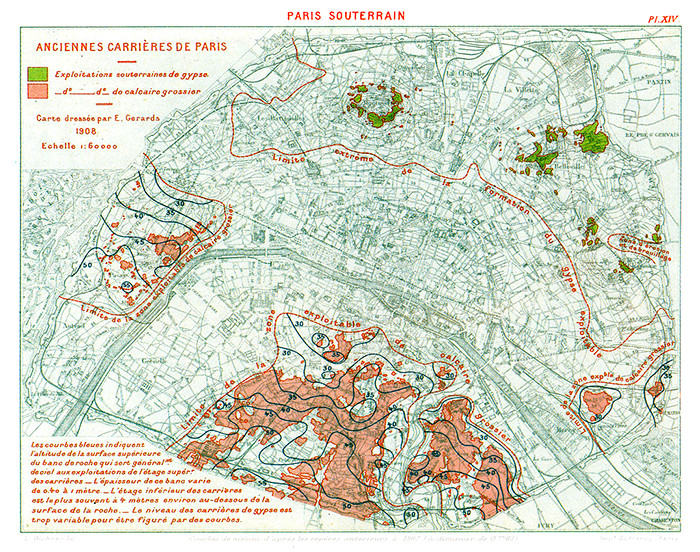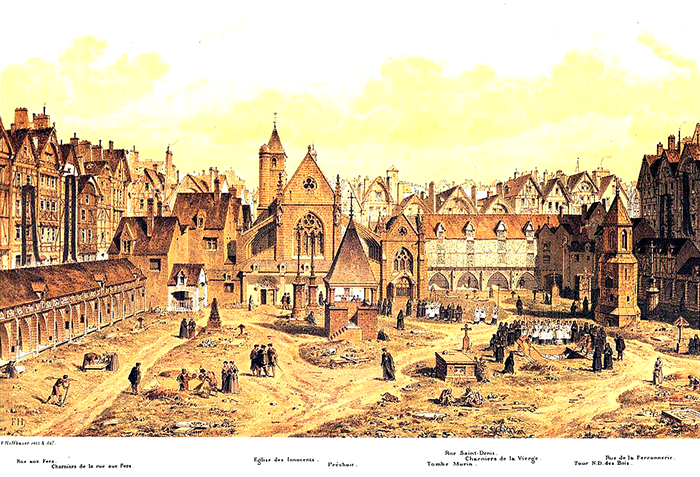Catacombs of Paris and the Grand Opera underground lake
The corridors well known as Parisian catacombs are full of mystery and romance in one’s imagination, but in reality there are 300 km of more than substantial underground tunnels under the 5, 6, 7, 12, 13, 14, 15, 16 and 20 districts. Nevertheless people rarely think about its origin, taking the catacombs as some kind of a concept.

Panorama – Eiffel Tower in Paris
Currently, this is the place where brave wonderers explore new routes in the company of many dead Parisians. The catacombs on the right bank of the river Seine are currently used as ossuaries. But it was not their original purpose in the beginning of their history.

On the map marked underground areas
The quarries and Cemetery of Holy Innocents
Up until the XVIII century it was the set of caverns, where the special Lutetian limestone was quarried. Citizens of Lutetia built their first stone houses of it and later Paris citizens constructed their world-famous architectural sights, then it was used more for decoration. For many centuries mines of Paris supplied materials for the rapidly growing capital of France.
In 1786 almost abandoned quarries got their new purpose. It was caused by infamous Cemetery of Holy Innocents, well known by the adventures books of French writers. In fact, it is a small piece of land where the Joachim du Bellay square is situated now, in vicinity of the Chatelet les Halles.

Cemetery of the innocent – the area of Joachim du Bellay
The small cemetery was intended for newborns, poor, tramps, later executed. The number of buried there in the years of its existence is estimated about 2 million people. The burial traditions were different at that time, in this case as many as possible bodies often were stocked in one grave, layered with ground.
With common graves being in practice at the space that was not sufficient for the number of burials, the sanitary conditions in the area became unbearable by the end of the XVIII century. The stone walls had been keeping the soil with bodies for many years until the excessive rains in autumn of 1780 made the contents of the cemetery too heavy burden and the walls gave in.

The square Joachim du Bellay today, in the middle of the square “Nymphs fountain” or as it is called “Fountain of the Innocents”, in the style of the French Renaissance
The incident wore thin the patience of the citizens and prefecture and although the burials there were banned by Louis XV in 1763, the special order of 1780 ended the very existence of the place. Legend has it that an opening to the catacombs appeared nearby because of the same rain. The decision to move the remains to the catacombs was just logical and the task was completed by 1786. At present there is a beautiful square and nothing resembles about its dramatic past except the original fountain of Nymphs which was moved from the Cemetery of Innocents where it was erected in the XVI century.
Of course like many other places of burial the catacombs on the right bank of the river Seine quickly acquired with legends and ghost stories.
The underground lake beneath the building of the Paris Opera
Later the image was successfully romantisized by Gaston Leroux’s novel “The Phantom of the Opera”. The action took place in the basement of the Opera Garnier with its fictional underground lake and secret passages leading to the catacombs.

In the figure, the building of the Opera Garnier in Paris, the lake underneath
By the way, the underground water reservoir exists in reality, although it is far more modest in size, no boats may float there. It appeared as a result of the engineering solution for the constant flooding of the basement. Charles Garnier made the decision to preserve underground part of the Grand Opera by constructing the artificial reservoir for excessive water that could not be avoided by other means.
There are stories about catfish and sometimes carps living there, being fed by technical workers of the Opera. It is unknown how much fish one can find under the Opera building but according to the Telegraph newspaper information French firemen swim there quite regular when training their skills of diving in the dark waters.

Reservoir of water under the building of the Paris Opera. Source: xavier.veilhan/yatzer
The catacombs in Paris
The catacombs on the left bank of the river Seine lost its functions by the end of XIX century, the storage of the limestone decreased and new materials, like concrete, appeared in the construction industry. However the catacombs were used for champignon farming for almost a century with a great success.
The construction of the Paris metro worsened the conditions for the mushroom farming. By 70s the number of the farms had lowered critically causing “the Parisian champignon” to leave the gourmet foods market.

Underground farm for growing mushrooms
Throughout its history the catacombs often hid those who were opposed the current regime. That’s why the first half of the XX century remembered the catacombs first of all as a shelter for the members of the Resistance. The second part of the XX century was the time when the catacombs were closed due to several acts of vandalism and for safety.
The relevant decree was issued on November 2, 1955. Nevertheless, many Paris citizens and tourists continued entering the kingdom of dead for different purposes – new scary routes, parties, graffiti and others.
The section of the catacombs 1.7 km long was opened officially on July 14, 2005 for visiting. The tourist route with the entrance at the Denfert-Rochereausquare is very popular.

The Catacombs of Paris are opened for tourists. Source: fototelegraf.ru
Tourists who are not afraid of hardening the romantic image of Paris may witness themselves there that the City of Lovers literally stands on the bones and sculls of its previous citizens, taken from its oldest cemeteries and then carefully and sometimes even artistically stored in its underground veins.

Entrance to the Paris catacombs
It is not noticeable perhaps from the first sight, but once found impresses with the inscription “Stop, This is the Empire of the dead”.
Address: 1, Avenue du Colonel Henri Rol-Tanguy – 75014 Paris, the excursion takes about 1.5 hours.
On the other hand the alternative use of the Parisian underground space solved some urban problems caused by its rapid development and helped the creation of the world famous architectural and bookish images of the capital of France.
Additional articles
Select an article of interest:
Mongolia designs new railway “Bohdan”
March 1, 2022
The construction of largest hydraulic tunnel has begun in Qatar
February 28, 2022
JSC "VO "Mashinoimport" supplied escalators for the Novosibirsk metro
December 22, 2021
Russian city Samara plans to build a metro
December 17, 2021
Tell us about our article to your friends,
sharing a link in a social network















Comments (0)
I hereby confirm that I am familiar with the privacy policy of
and agree to the processing of personal data. Read more